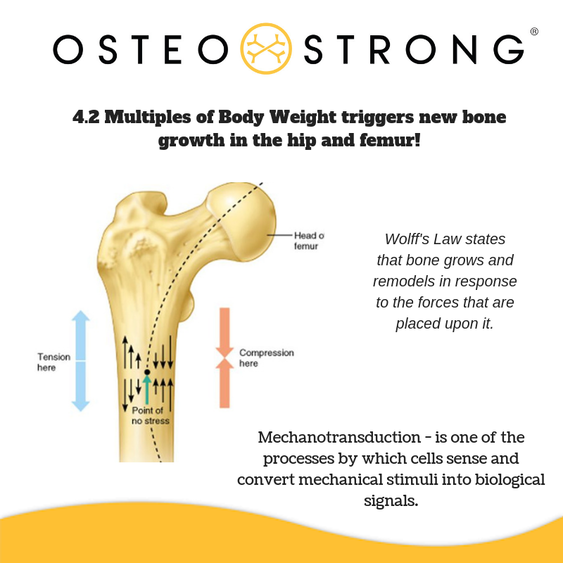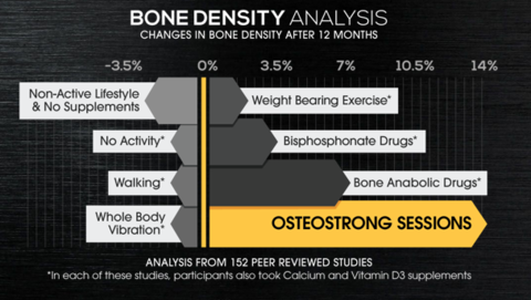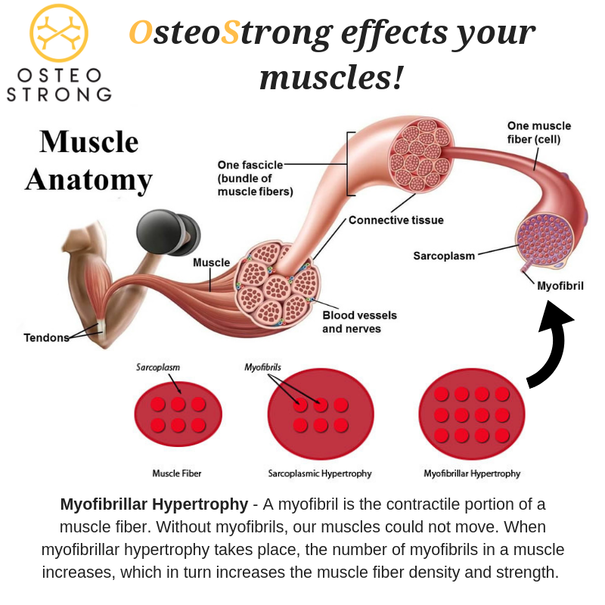The Science of Skeletal Strength Conditioning
4.2 Multiples of Body* weight is key to regenerate healthy new bone tissue in the hips!
Swimming/Cycling = 0 MOB
Brisk Walk = 1-2 MOB
Running = 3 MOB
Jump Training = 3-4 MOB
Swimming/Cycling = 0 MOB
Brisk Walk = 1-2 MOB
Running = 3 MOB
Jump Training = 3-4 MOB
Recently researchers at the University of Bristol gathered male and female adolescents — the body accumulates bone mass rapidly at this time of life — and had them go about their daily routines while they wore activity monitors. The bone density of the volunteers’ hips was also measured.
A week later, the scientists reclaimed the monitors to check each teenager’s exposure to G forces, a measure of impact. Those who experienced impacts of 4.2 G’s or greater — though these were infrequent — had notably sturdier hipbones. Additional work done by the same researchers showed that running a 10-minute mile or jumping up onto and down from a box at least 15 inches high was needed to produce forces that great. The significance of these findings is that people should probably run pretty fast or jump high to generate forces great enough to help build bone.
***Unfortunately, few older adults are likely to be doing so. In follow-up experiments, the same researchers equipped 20 women older than 60 with activity monitors and ran them through an aerobics class, several brief and increasingly brisk walks and a session of stepping onto and off a foot-high box. None of the women reached the 4-G threshold — none, in fact, generated more than 2.1 G’s of force at any point during the various exercises.***
A week later, the scientists reclaimed the monitors to check each teenager’s exposure to G forces, a measure of impact. Those who experienced impacts of 4.2 G’s or greater — though these were infrequent — had notably sturdier hipbones. Additional work done by the same researchers showed that running a 10-minute mile or jumping up onto and down from a box at least 15 inches high was needed to produce forces that great. The significance of these findings is that people should probably run pretty fast or jump high to generate forces great enough to help build bone.
***Unfortunately, few older adults are likely to be doing so. In follow-up experiments, the same researchers equipped 20 women older than 60 with activity monitors and ran them through an aerobics class, several brief and increasingly brisk walks and a session of stepping onto and off a foot-high box. None of the women reached the 4-G threshold — none, in fact, generated more than 2.1 G’s of force at any point during the various exercises.***
The Muscular Effect of OsteoStrong
The 2 types of hypertrophy are Sarcoplasmic and Myofibrillar (also called sarcomere hypertrophy in certain textbooks).
Sarcoplasmic hypertrophy is when the sarcoplasm (the fluid inside the muscle cell) increases it’s volume which makes the muscles larger and fuller. Unfortunately, science shows us this does virtually nothing for force production, meaning it is not what makes you stronger and does not improve muscular performance. The sarcoplasm is the fluid in the muscle cell which contains glycogen, minerals, fats, and dissolved proteins, so it’s easy to see how this would not improve function or muscular contraction.
Myofibrillar hypertrophy is an enlargement of the muscle fiber as it gains more actin and myosin proteins, which are the contractile proteins (the myofibril is a rod like unit of muscle which contains these muscle proteins). The myofibril (and the smaller unit, the sarcomere) is where the muscle contracts, so the more and bigger myofibrils (and sarcomeres) we have, the stronger we become.
*This is the type of hypertrophy that leads to increased muscle force production.*
We Would Love to Have You Visit Soon!
HoursSee Online Calendar
|
|



